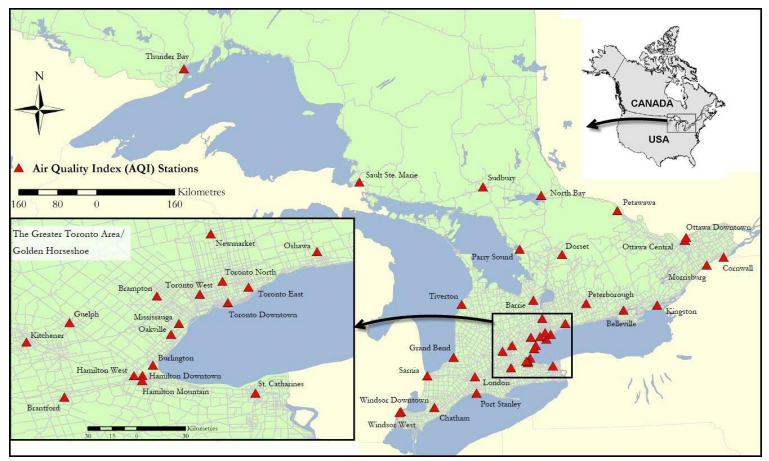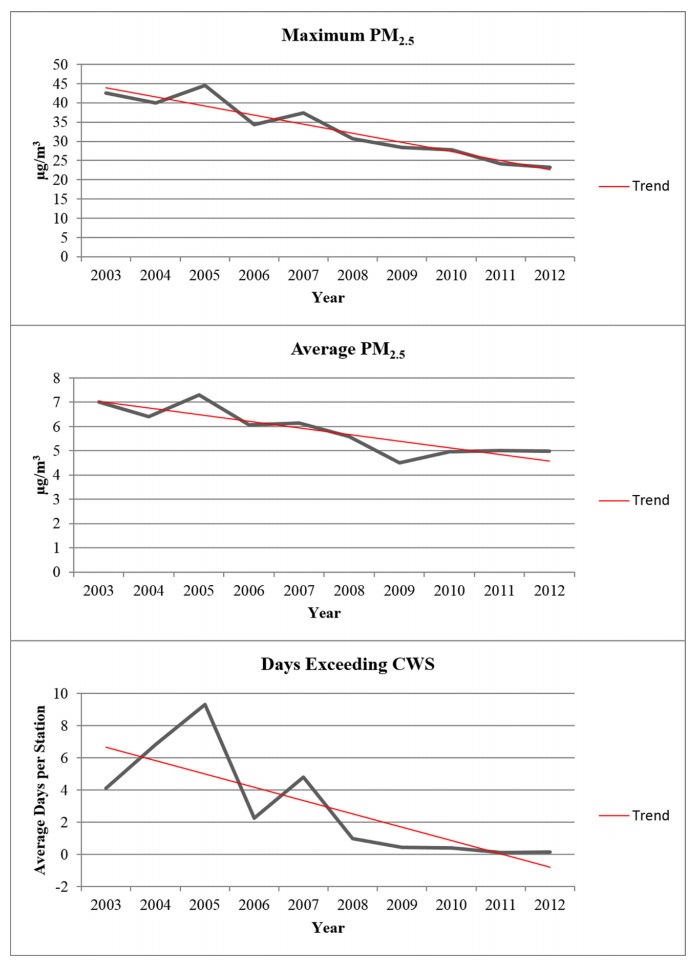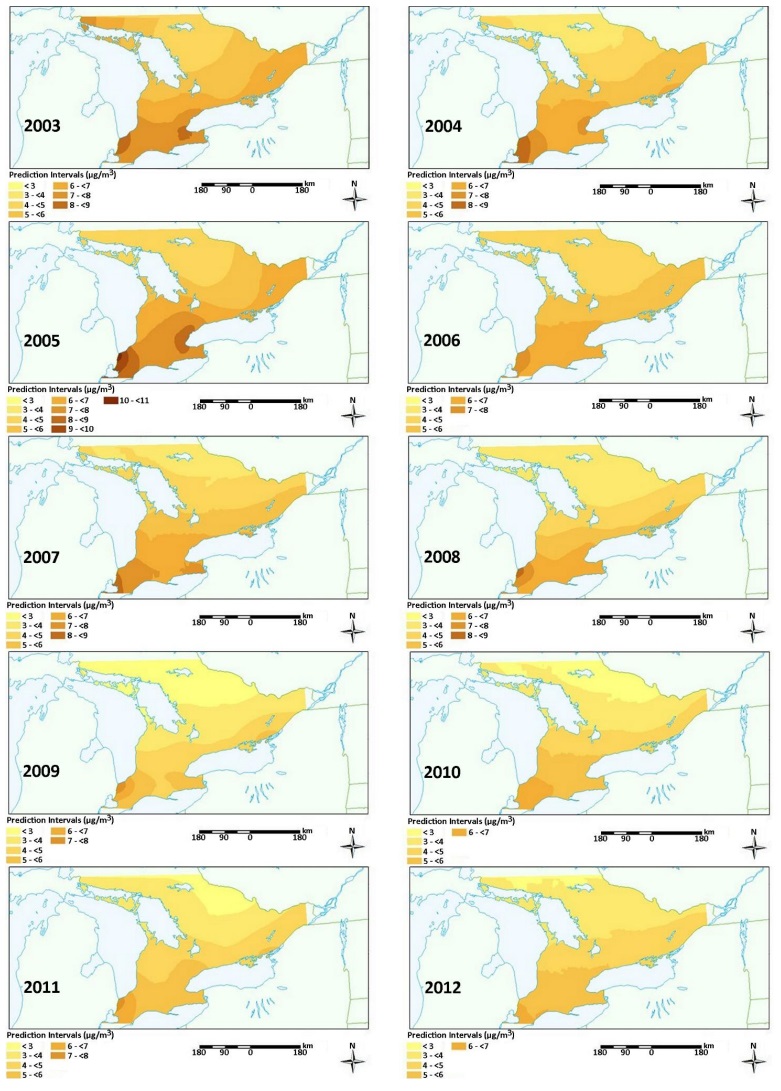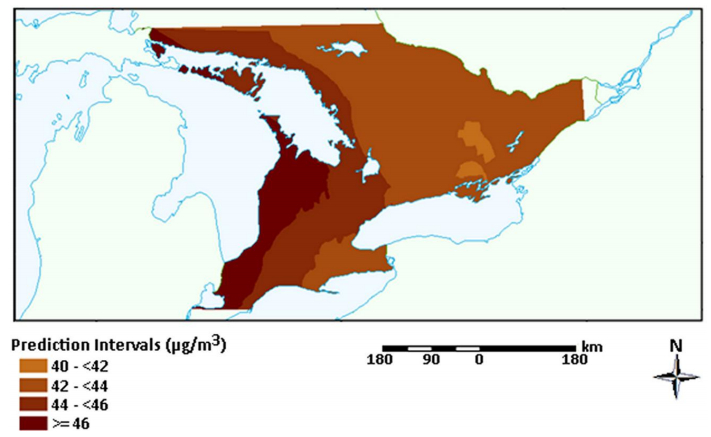1. Introduction
Ontario is Canada's second largest province by area, and largest by population. It contains some of Canada's largest and most urban areas, such as Toronto, Windsor, Ottawa, and Hamilton. This also means that Ontario has the highest automobile use and some of the heaviest industrial activity in Canada. As Geddes et al. [1] pointed out, vehicle registration in Ontario increased by 700,000 between 2000 and 2007. According to the Ontario Ministry of the Environment (MOE) Air Quality Report 2011 [2], automobile traffic is one of the main causes of air pollution; it accounts for the release of approximately 36 percent of volatile organic compounds (VOCs), 71 percent of nitrogen oxides, and 24 percent of fine particulate matter. As a result, it has been found that southern Ontario has the highest levels of air pollution in Canada [3].
Fine particulate matter is an especially concerning contaminant. It is one of the main ingredients of smog, a factor of utmost importance when considering air quality in Ontario, and it has been found to cause serious health effects. Therefore, providing a detailed spatial analysis of fine particulate matter would be greatly beneficial in understanding air quality trends and generating information for policy makers in Ontario.
1.1. Fine particulate matter (PM2.5)
Fine particulate matter has a diameter of 2.5 μm or less. This classification is important, as the size of the particles relates to how concerning the particulate matter is. Particulate matter (PM) has been studied extensively in the literature [4,5,6,7,8,9], and PM2.5 is receiving more focus as the smaller particle size makes it easier for the contaminant to enter the lungs and affect health. According to Sharma and Maloo [10], finer particulate matter has the strongest health effects. Williams [11] also cites the World Health Organization (WHO) in concluding that there is now more reason to suggest that PM2.5 is of greater concern than PM10 due to its fine fraction. Amatullah et al. [12] studied different sizes of particulate matter and how this variability can have varying health effects on mice. They found that coarse (PM2.5–10), fine (PM0.15–2.5), and ultrafine (PM0.2) particulate matter all adversely affect lung function and airway responsiveness. In addition, it was found that coarse and fine particulate matter (such as present in Ontario) does most of the health impairment at the site where it is deposited in airways [12].
1.2. Canada-wide standards (CWSs)
Canada-Wide Standards (CWSs) were developed for many contaminants by the Canadian Council of Ministers of the Environment (CCME) in 2000 [13]. These standards were developed to publish acceptable levels of the various contaminants, and also as goals for Canada as a whole to reach. The level for fine particulate matter, expressed as a 24 hour average, is 30 μg/m3. There are also standards developed at the provincial level for different contaminants, however one has not been developed for fine particulate matter and Ontario uses the CWS as its standard.
2. Study area and data
Ontario is Canada's largest province, and subsequently contains some of its largest and most industrial cities. Cities such as Toronto and Ottawa represent large populations, while others such as Windsor and Hamilton represent major industrial centres. Both of these factors are major considerations when examining air quality and pollution. Since 2003, Ontario has experienced major population growth, along with an increase in automobile numbers and a growing industrial sector, all of which have an impact on air quality. According to the 2011 Ontario Air Quality Report, a large portion of air pollution can be attributed to automobiles and industrial activities [2].
This research focuses on southern Ontario, as the Air Quality Index (AQI) station network of the MOE (see the next section) covers this area most extensively, and does not have any stations in the far northern areas of Ontario. Also, southern Ontario has a much higher population, automobile count, industrial activity and closer proximity to the United States border than the north, so it is of more concern when examining air pollution. Figure 1 shows the distribution of AQI stations throughout southern Ontario.
Data Collection
The data for this study were collected by the Ontario Ministry of the Environment from 2003 until 2012. Each AQI station measures hourly ambient concentrations of up to six pollutants, including ozone, fine particulate matter, nitrogen dioxide, carbon monoxide, sulphur dioxide, and total reduced sulphur compounds. Data for fine particulate matter were collected hourly at every station, from 2003 to 2012.
Since hourly data exist for every day in the 10 year period, they were aggregated before analysis based on the literature [2,14,15], as well as the CWSs. Both the World Health Organization (WHO) and the CCME utilize the same time frame for fine particulate matter, which was measured as an average over 24 hours. Also, to allow for more accurate surface predictions using ordinary kriging, the Thunder Bay AQI station was omitted from the analysis. Due to the remote nature of this station, the prediction surface between it and the other AQI stations would not be accurate and the results would be skewed. Therefore, only 39 of the 40 stations were examined, focusing on southern Ontario. Only ozone and fine particulate matter are measured at all of the AQI stations. The next most measured pollutant was nitrogen oxides (NOx), which were measured at 36 of the 40 stations, while the other pollutants were measured sparsely throughout the AQI network.
3. Methods
An ordinary kriging spatial interpolation method was utilized to assess air pollution in southern Ontario. One of the advantages of ordinary kriging over other spatial interpolation methods is the ability to statistically validate the prediction surface that is produced [16,17]. There are several statistics generated when the analysis is performed that can be compared to ideal numbers so the validity of the model can be assessed. These statistics include the Mean Prediction Error (MPE), the Root-Mean Square Prediction Error (RMSPE), the Average Standard Error (ASE), and the Standardized Root-Mean Square Prediction Error (SRMSPE). To achieve acceptable results, the statistics should be the following: the MPE should be as close to 0 as possible, the ASE should be as small as possible and below 20, and the SRMSPE should be as close to 1 as possible. If the SRMSPE is greater than 1, there is an underestimation of the variability of predictions; if it is less than 1, there is an overestimation of the variability [18]. Additionally, three models (Spherical, Exponential, and Gaussian) were compared based on previous ordinary kriging studies [16,17,19] to determine which produced the best output statistics. These statistics and models were adhered to when choosing the best parameters for ordinary kriging.
The maximum 24 hour average and the mean 24 hour average were applied to each station for each year. These levels are both based on methods found in the literature [2,20], as well as the CCME CWSs [13]. To examine the distribution of contamination levels, the number of averages (24 hours) that fell above and below the CWS were examined as well. This gives good insight into how Ontario is exceeding, meeting, or falling below the CWSs for each year. Python programming language scripts were written to parse the relevant data to apply to each station. The raw data came in a table format with contaminant readings for each hour, day, station, and year. The script returned the highest 24 hour average for each station from each year, as well as finding the average of all the 24 hour readings.
4. Results
Fine particulate matter does not rely on other chemicals or meteorological conditions for its creation, and so does not have a season or time of year in which it is particularly serious. Therefore, dates for the maximum PM2.5 reading are distributed throughout the year, and are not focused in the summer months.
All of the fine particulate matter findings relate to air quality in southern Ontario. Maximum PM2.5, while fluctuating from 2003 to 2007, has experienced a steady decline since then, and has fallen to under 25 μg/m3, which is not only a large decrease from the approximately 42.5 μg/m3 it was in 2003, but also falls below the CWS. The results can be seen in Figure 2.
A similar trend can be seen when looking at average fine particulate matter in Figure 2. Fluctuations from 2003 to 2007 can be seen, but since then it has dropped to its lowest point in 2009, and from then has leveled off at approximately 5 μg/m3, lower than the 7 μg/m3 average in 2003. Perhaps the most useful statistic is the average number of 24 hour periods in which the CWS was exceeded. Similar to the other graphs in Figure 2, fluctuations can be seen from 2003 to 2007, with the average number of days per station exceeding the CWS reaching almost 10 in 2005. Since 2007, however, this number has dropped drastically, culminating in close to 0 days in 2012 that exceeded the CWS per AQI station.
The ordinary kriging maps (Figure 3) for average fine particulate matter levels for each year were then examined. For the most part, the prediction surfaces slightly underestimated the variability of predictions for most of the years, but slightly overestimated the variability of predictions for 2003,2004, and 2009. The statistics can be seen in Table 1.
Table 1. Ordinary kriging average fine particulate matter statistics.
| Year |
Model |
MPE |
ASE |
SRMSPE |
| 2003 |
Exponential |
0.008555585 |
1.313369575 |
0.929714455 |
| 2004 |
Spherical |
0.070017801 |
1.228212032 |
0.995646593 |
| 2005 |
Spherical |
0.095736946 |
1.110966834 |
1.049512054 |
| 2006 |
Gaussian |
0.022354019 |
0.930343775 |
1.003293787 |
| 2007 |
Spherical |
0.055951884 |
0.961749278 |
1.014364628 |
| 2008 |
Spherical |
0.053981896 |
0.914757062 |
1.02941605 |
| 2009 |
Spherical |
0.031358227 |
0.918704231 |
0.974947744 |
| 2010 |
Spherical |
0.029973126 |
0.953317665 |
1.044477564 |
| 2011 |
Spherical |
0.056066514 |
0.929530686 |
1.003947428 |
| 2012 |
Spherical |
0.029819743 |
0.967414484 |
1.033578291 |
The 2003 PM2.5 kriging prediction map shows general north to south decreasing concentrations, with the exception of the Sault Ste. Marie station, the most north-westerly. The area east to west from the Golden Horseshoe to the Windsor area has the highest concentrations, and pockets above 8 μg/m3 are evident near Hamilton and Windsor. The 2004 surface shows a similar trend to 2003, but with a reduction in predicted PM2.5 concentrations in many areas. As seen in Figure 2, average levels did drop slightly from 2003 to 2004, and the map reflects that drop. Most of the northern part of the prediction surface now falls under 4 μg/m3, a level at which no area was in 2003. Similar pockets exist around Hamilton and Windsor, though around Hamilton it fell to under 8 μg/m3, while the area around Windsor remained the same. The 2005 results represent the year with the highest average PM2.5 concentrations, and Figure 2 reflects that statistic. While sharing the similar north-south trend as the other years, all of the areas fall above 4 μg/m3, as in 2003. Hamilton and the surrounding area are also similar to 2003, but the concentrations in the Windsor area have increased. A large portion of the area is now above 9 μg/m3, and a small area exceeds 10 μg/m3. A drastic reduction in fine particulate matter levels across the province can be seen when examining 2006 as compared to 2005. The northern part of the prediction surface is similar, falling between 4 to 5 μg/m3, but it is the southern part, especially near Windsor and the United States border that shows much lower concentrations. No part of that area now falls above 8 μg/m3, whereas in 2005 there was a small area that fell above 10 μg/m3. As well, a region around Hamilton that had concentrations between 8 and 9 μg/m3 has fallen to between 6 and 7 μg/m3.
The lowest average fine particulate matter concentrations since 2003 were observed in 2006. According to the MOE Air Quality in Ontario 2006 Report, this year had the lowest recorded PM2.5 statistics since it was included in the Smog Alert Program in 2002 [21]. The 2007 results show similar trends to 2006, but extend in both directions. For example, the northern part of the study area now shows concentrations between 3 and 4 μg/m3, where it had been between 4 and 5 μg/m3 previously. Conversely, around the Windsor area, average concentrations rose to between 8 and 9 μg/m3 where they had been between 7 and 8 μg/m3 in 2006, and the Niagara Falls area also experienced an increase. The 2008 surface shows a similar trend to 2007, but has a larger area in the north that falls in the lowest prediction interval category. However, a smaller area falls into the highest two prediction intervals, which is the area surrounding Windsor. Similar trends can again be seen in 2009, but an overall reduction of predicted fine particulate matter levels is evident. In the north, there is a large area where predicted PM2.5 levels fall below 3 μg/m3, the first time an area has been in that category in the study period. At the higher end, the area around Windsor encompassing the highest two prediction intervals is identical, but now falls between 6 and 8 μg/m3, rather than 7 and 9 μg/m3 in 2008. It can be seen that 2009 is the year with the lowest average fine particulate matter levels in the analysis period. It was found to have the lowest PM2.5 concentrations for the whole year averaged over all of the AQI stations. The 2010 results show the lowest prediction levels across the province. Compared to 2009, a similar area falls below 3 μg/m3, but no areas exceed 7 μg/m3 for the first time in the study period. The 2011 surface shows a slight increase in fine particulate matter from 2010. A small area near Windsor once again exceeds 7 μg/m3, and there is a smaller area in the north that falls below 3 μg/m3. Overall the trends are very similar to 2010 and there is no drastic change in predicted PM2.5 levels. The 2012 results represent a reduction in predicted fine particulate matter levels since 2011 and reveal one of the lowest concentration prediction surfaces overall. Though the area in the northern part of the kriging surface below 3 μg/m3 is smaller than the previous year, the area in the south exceeding 6 μg/m3 is also the smallest in the study period.
The maximum fine particulate matter readings were also examined using ordinary kriging for two years: 2005, the year with the highest levels, and 2012, the year with the lowest. Both prediction surfaces slightly underestimated the variability of predictions, with the SRMSPE being above 1. The statistics can be seen in Table 2.
Table 2. Ordinary kriging maximum fine particulate matter statistics.
| Year |
Model |
MPE |
ASE |
SRMSPE |
| 2005 |
Exponential |
–0.047755425 |
4.2781557 |
1.083965352 |
| 2012 |
Spherical |
0.014626286 |
4.317073273 |
1.078006144 |
Figure 4 (2005) shows high concentrations across the province. Only a small area falls between 40 and 42 μg/m3, and, no area falls below the CWS. In 2012, the reduction in maximum fine particulate matter levels since 2005 resulted in the entire prediction surface having concentration levels below the CWS. This means that even for the 24 hour periods in which PM2.5 levels were the highest for the entire year, the CWS of 30 μg/m3 was not predicted to be exceeded. Based on Figure 2, as well as findings from the MOE [2], maximum (and average) PM2.5 concentrations have declined steadily since 2003 and have been reduced by approximately 30 percent [2].
5. Discussion
Fine particulate matter levels decreased steadily across Ontario from 2003 to 2012. The years with the highest averages and prediction surfaces were 2003 and 2005, while 2010 and 2012 appeared to have the lowest prediction surfaces province-wide. As well, average maximum fine particulate matter and 24 hour periods that exceeded the CWS have also greatly declined since 2003. Fine particulate matter levels were shown to be the highest in major population centres and industrial cities. For example, the Windsor area almost always had the highest predicted concentrations, and the Golden Horseshoe area near Hamilton was also a hot spot, particularly from 2003 to 2005 (Figure 3). These two cities are major centres of industrial and manufacturing activities in Ontario. Windsor is also just across the border from the Detroit, Michigan which is a key industrial centre in the United States. The results show that higher PM2.5 concentrations are correlated with high levels of industrial and anthropogenic activity.
One of the reasons for the decline in pollutant concentrations is a result of government regulations and programs, one of which is Ontario's Drive Clean program. Drive Clean is an initiative created by the MOE to reduce vehicle emissions. Vehicle emissions create over 18 percent of pollution in Ontario that can lead to the creation of smog, and Drive Clean aims to mitigate those emissions. The program reduces emissions by an annual average of 36 percent [22]. This is likely a major factor when looking at the reduction of fine particulate matter levels across Ontario, since approximately a quarter of all PM2.5 emissions come from automobiles. The program was implemented to reduce emissions by focusing on proper vehicle maintenance and identifying emissions problems. Drive Clean acts to improve vehicle fuel consumption and lessen pollutant release [22].
The notion of trans-boundary pollution is one of the main things to take into consideration when examining air pollution in southern Ontario. Both the CCME and governments in Canada and the United States have agreements concerning trans-boundary air pollution to mitigate the effects and to lower emissions that could harm both sides. Therefore, despite government efforts such as Drive Clean, much of the cleanliness of Ontario's air is dependent on other sources. This was likely the cause of the air quality trends experienced, especially when examining fine particulate matter. There was a general north-south trend of increasing concentrations, likely due to the proximity of the southern part of Ontario to the United States. As mentioned previously and in additional findings by Galvez [23], approximately 60 percent of ozone during smog episodes was due to anthropogenic emission release from the nearby United States.
The distribution of points may also have had an effect on the outcomes of some of the prediction surfaces. This was mainly an issue for the Sault Ste. Marie station, as it was fairly remote and distant from the rest of the stations. Therefore, if it had an anomalous year, its value would have a strong influence on the surrounding area without an AQI station. The Thunder Bay AQI station was omitted from analysis for this specific reason, so while the omission of Sault Ste. Marie would result in a less complete analysis, it may have provided more accurate results for the rest of the area. For example, in 2003 the Sault Ste. Marie station has a high concentration. Since the closest AQI station to the east is still quite far, the prediction surface is heavily based on that reading. The result is relatively high predicted values for the surrounding area, which may not be an accurate representation of realistic concentrations. With this in mind, the point density among the 39 stations that were analyzed could have affected the results. Areas in which there was a high density of points, such as the Greater Toronto Area, would have produced more accurate results, as the distance in between the stations is smaller and therefore the predicted readings in between will be closer to observed measures. In areas where the points are far apart, the prediction surface can become less accurate since the observed values it relies on are not as close.
A spike in ambient fine particulate matter concentrations was experienced. There is little literature or information as to why this occurred but it is likely related to the number of smog alerts. In 2011, there were only 5 smog advisories lasting a total of 9 days. Comparing this to 2012, there were 12 smog advisories lasting a total of 30 days [24]. Higher levels of fine particulate matter led to an increase in the number of smog episodes across Ontario.
6. Conclusion
This analysis provided a spatial investigation of air quality trends in Ontario since 2003. Fine particulate matter was examined as it has been proven to be detrimental to human and environmental health. It is also one of the two main ingredients of smog. The findings can be used by environmental organizations and for planning based on current air quality reports published in Ontario. The annual air quality report released by the MOE, for example, only includes readings from 19 of the 40 AQI stations, and does not include a strong spatial aspect, so kriging prediction surfaces can benefit the statistical analysis of air pollution in Ontario.
It was found that from 2003 to 2012, average fine particulate matter concentrations generally decreased and maximum levels were also reduced. The average amount of times the CWS was exceeded has also greatly declined since 2003, indicating improvement in ambient air quality in southern Ontario.
Conflict of interest
The authors declare no conflict of interest.










 DownLoad:
DownLoad: 









